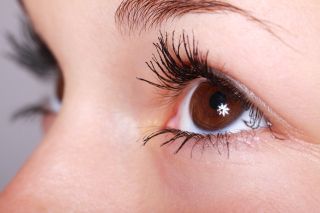Attention
12 Ways Eye Movements Give Away Your Secrets
Your eye movements unconsciously give away secret personal information.
Posted May 7, 2015 Reviewed by Ekua Hagan

Staring into the eyes of Mona Lisa is unnerving. Regardless of your vantage point, Mona Lisa appears to shift her gaze to make eye contact and stare you down. What nonverbal cues do the movements of her eyes communicate to you? The illusory movement of Mona Lisa's eyes has struck an emotional chord in onlookers since Leonardo da Vinci painted this portrait in the early 16th century.
For eternity, homo sapiens have relied on eye movements to convey and interpret important nonverbal cues at a conscious and unconscious level. Understanding eye movements has been key to our evolution and survival for eons. The eyes of Mona Lisa tap into this innate aspect of our human nature.
Human beings are the only primates with a large, bright, and highly visible white part of the eye—which is called the sclera. Why did humans evolve to have more visible eye whites and to rely on eye movements as a form of nonverbal communication? The latest scientific research shows that eye movements are key to our well-being, bonding, and survival. The highly visible sclera makes it possible for us to easily track saccades and eye movements in others.
What Are Saccades?

Saccades are the eye movements made to receive visual information and shift the line of vision from one position to another. We rely on the accuracy of saccades every millisecond of our lives. During normal day-to-day conditions, you make about 3-5 saccades per second. This amounts to about a half-million saccades a day.
Humans intuitively create a narrative based on the nonverbal cues from the saccadic rhythms, the speed of eye movements, as well as, the amount and angle of sclera that is exposed at any given moment.
We all know from life experience that the amount of eye white, the angle, and the directional speed of eye movements plays a primal role in our interpretation of human interactions. An averted gaze, as well as direct eye contact, can have a wide range of meanings depending on the circumstance.
In previous Psychology Today blog posts, I've written about "The Neuroscience of Making Eye Contact" and how "The Whites of Your Eyes Convey Subconscious Truths." For this post, I've compiled a checklist of "12 Ways Eye Movements Give Away Your Secrets" based on the latest scientific research.
12 Ways Your Eye Movements Reveal Personal Information
1. Rapid eye movements indicate impulsive decision-making.
In a 2014 study, researchers at Johns Hopkins Medicine reported that people who are less patient or impulsive tend to move their eyes at greater speed. When the speed of the volunteers' saccades was compared to their impulsivity during a test of patience, there was a strong correlation.
The researchers concluded that people who make rapid eye movements tend to be more impatient. This correlation may be caused by a fundamental link between how the nervous system evaluates time and reward in controlling movements and during decision-making processes.
2. Plodding eyes reflect a wandering mind.
A 2010 study identified a wandering mind by tracking how the eyes moved during "mindless reading." Mindless reading occurs when the eyes continue moving across the page even though the mind is thinking about something unrelated to the text and not absorbing the information.
The researchers at the University of Pittsburgh found that eye movements vary depending on if the reader is paying attention or if his or her mind is wandering. During normal reading, the eyes tend to zip from one word to the next word. When someone's mind is wandering, however, the eyes fixate longer on individual words and plod along the page and the reader generally doesn't absorb the material.
3. Slow eye movements indicate your level of fatigue.
In 2014, an international team of scientists tracked the various speed of saccadic movements to create a metric for gauging levels of fatigue. For this study, the researchers enlisted medical residents who had to work 24-hour medical shifts.
The more fatigued someone became, the more slowly their eyes moved as saccadic speeds diminished. This research reveals that the velocity of your saccadic movements is an excellent index to objectively measure levels of fatigue.
4. Tracking eye movements can shift your moral compass.
A March 2015 study by an international team of researchers reported that our moral decisions can be influenced by where our eyes are focused when we make a decision. The researchers used a new experimental method to track participants' eye movements. They concluded that the processes needed to reach a moral decision are interlinked with our eye movements and how we view the world.
5. Gaze cues can reveal your political temperament.
A 2011 study, "The Politics of Attention: Gaze-Cuing Effects are Moderated by Political Temperament," from Univesity of Nebraska-Lincoln found that liberals and conservatives had different eye-movement responses to a visual cue. The researchers measured both liberals' and conservatives' reaction to "gaze cues," which are an indication of a person's tendency to shift his or her attention.
In this study, liberals responded strongly to a visual prompt that shifted their eye gaze, along with their attention in the direction suggested by a face on a computer screen. On the other hand, conservatives had less eye movement in response to the visual prompt and were less likely to shift their gaze or attention.
6. Rapid eye movement (REM) sleep minimizes painful memories of PTSD.
A 2011 study from University of California, Berkeley found that time spent in rapid eye movement (REM) sleep can help people with post-traumatic stress disorder (PTSD) minimize painful memories. The researchers, led by Matthew Walker, found that during REM sleep, stress chemistry shuts down and the brain processes emotional experiences in a way that can take the edge off painful memories.
These findings offer a possible explanation as to why people with PTSD have a hard time recovering from distressing experiences and suffer recurring nightmares if they are unable to sleep through an REM cycle.
7. Rapid eye movement (REM) sleep increases positive emotions.
A 2009 study reported that taking a nap that includes a period of rapid eye movement (REM) sleep refreshes the brain's empathetic sensitivity for evaluating human emotions by decreasing a negative bias and amplifying the recognition of positive emotions.
The researchers believe their results emphasize the importance of rapid eye movement sleep as part of a process that increases positive emotions and maintains optimal levels of social and professional mental health.
8. Jerky eye movements can predict neurodegenerative diseases.
A 2012 study by researchers at the University of Southern California (USC) reported that certain neurological disorders can be identified through the study of eye movements. Their research provides new insights into how attention and gaze control are affected by specific neurodegenerative disorders.
Participants in the study simply had to "watch and enjoy" television clips while their eye movements were tracked and recorded. The eye-tracking data allowed researchers to decode each individual's neurological state based on his or her eye movements. Using the eye movement data, they were able to identify older adults with Parkinson's Disease with 89.6 percent accuracy.
9. Alterations in eye movements are an early indicator of Alzheimer's.
In a 2014 study, an international team of researchers reported that tracking the eye movements of individuals as they were reading could be used to identify impairments in working memory and was an early indication of Alzheimer’s disease.
The researchers found that patients with a probable diagnosis of Alzheimer's disease showed less focused visual exploration, including slower eye movements when they were reading. They also showed longer fixations when processing new information and had to read sentences a second time in order to grasp the full meaning and context of a written passage.
10. Involuntary eye movements can diagnose ADHD.
A 2014 study, published in the journal Vision, reported that involuntary eye movements accurately reflected the presence of attention-deficit hyperactivity disorder (ADHD). The researchers acknowledge that ADHD is the most commonly diagnosed—and often misdiagnosed—behavioral disorder in American children.
They’re hopeful that their research on eye movements can provide an objective tool for medical professionals to accurately diagnose ADHD. An incorrect ADHD diagnoses can lead to the overprescription of drugs such as Ritalin, Adderall, and Dexedrine.
11. Lack of eye contact is the earliest marker for autism in young infants.
A 2013 study, published in the journal Nature, found that eye contact during early infancy may be the earliest indication of autism spectrum disorder (ASD). Babies typically begin to focus on human faces within the first few hours of life. Learning how to pick up social cues unconsciously by paying attention to another person's eyes is key to social connection. Children with autism, however, don't exhibit interest in making eye contact which makes it difficult to read faces.
Typically, autism isn't diagnosed until after the age of two when other delays in a child's social behavior and language skills begin to reveal themselves. Tracking eye movements offers earlier markers for autism. The sooner autism is diagnosed, the higher the odds are that the treatment interventions will be effective.
12. Abnormal eye movements can diagnose mental illness.
Researchers at the University of Illinois at Chicago are studying how subtle abnormalities in eye movements can be used to diagnose mental illness and psychiatric disease. They've discovered that irregularities in how the eyes track a moving object reflect specific defects in the neural circuitry of the brain that correspond with particular types of mental disorders. For example, schizophrenic patients tend to have difficulty keeping their eyes focused on slow-moving objects.
Eye movement studies provide an inexpensive and non-invasive way to gain a deeper understanding of different brain abnormalities at the root of various psychiatric illnesses. Hopefully, in the near future, a better understanding of eye movements and related brain abnormalities will allow researchers to identify high-risk individuals earlier and enable specialists to create more targeted interventions for people with psychiatric disorders and mental illness.
For more information about research on eye movements and mental illness check out this YouTube video from UBC.
© 2015 Christopher Bergland. All rights reserved.
Follow me on Twitter @ckbergland for updates on The Athlete’s Way blog posts.
The Athlete’s Way ® is a registered trademark of Christopher Bergland.




